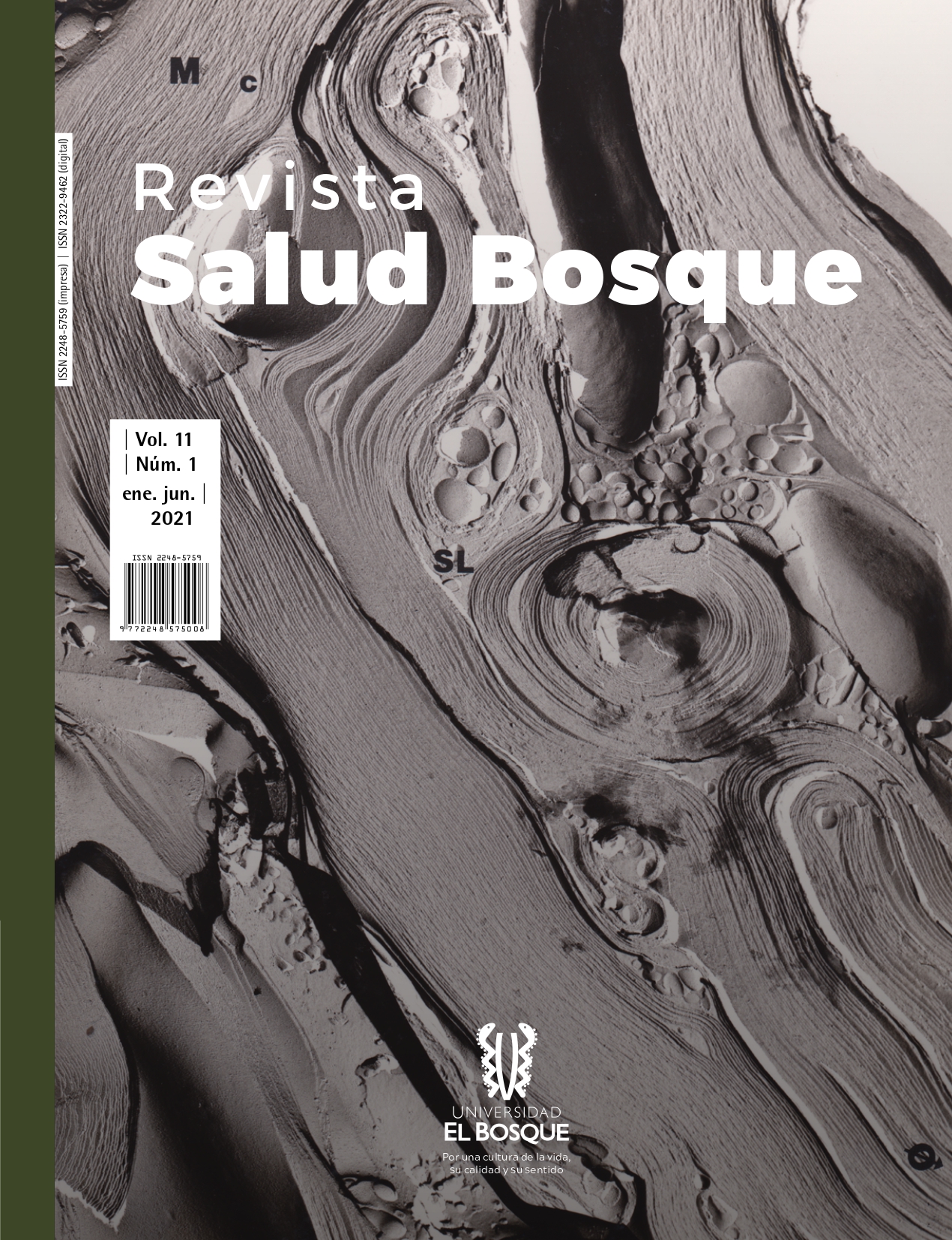Variabilidad genética y rol de los fenotipos oculares en el Síndrome de Stickler
DOI:
https://doi.org/10.18270/rsb.v11i1.3641Palabras clave:
Síndrome de Stickler, fenotipo vítreo, COL2A1, COL11A1, COL9A1, COL9A2, Oftalmoartropatía.Resumen
Introducción: El Síndrome de Stickler (SS) es una anomalía del tejido conectivo que se caracteriza por alteraciones oculares, orofaciales, auditivas y esqueléticas. Aunque existen cuatro tipos de SS, la mayoría de las formas clínicas presentan alteraciones oculares como alta miopía, degeneración vitreorretiniana, cataratas y desprendimiento de retina, siendo la causa más común de este último en la infancia.
Objetivo: Ampliar los conocimientos acerca de los genes involucrados en el SS y su expresión clínica, profundizando en el rol de los fenotipos oculares.
Metodología: En este trabajo realizamos una revisión del estado actual del SS consultando bibliografía de alto impacto y reciente publicación. Se hicieron búsquedas a través de PubMed, Hinari, SCIELO, Medline y se consultaron páginas dedicadas a estos temas como OMIM, OPHRANET, GeneMap, Genetest, Proteins, Gene, entre otros. Se utilizaron descriptores de búsqueda como “Síndrome de Stickler’’, ‘‘Stickler Syndrome gene’’, ‘‘ocular signs and Stickler Syndrome’’ and ‘‘Stickler Syndrome review’’.
Resultados: Fueron encontrados numerosos artículos acerca del SS, de ellos se citaron un total de 32, de los cuales 25 son del 2016 a la fecha, reportándose 4 genes principales: COL2A1, COL11A1, COL9A1, COL9A2. El COL2A1 y el COL11A1 son responsables del 95% de los pacientes con SS. Las alteraciones oculares son comunes en la mayoría de los tipos.
Conclusiones: El diagnóstico del SS se basa en criterios clínicos-radiológicos y aunque la confirmación molecular es determinante, la evaluación del vítreo puede ser una guía útil para un análisis genético eficiente.
Descargas
Referencias bibliográficas
Stickler GB, Belau PG, Farrell FJ Jones JD, Pugh DG, Steinberg AG, Ward LE. Hereditary progressive arthro-ophthalmopathy. Mayo Clin Proc. 1965; 40:433–55.
Zhou L, Xiao X, Li S, Jia X, Wang P, Sun W, Zhang F, Li J, Li T, Zhang Q. Phenotypic characterization of patients with early-onset high myopia due to mutations in COL2A1 or COL11A1: Why not Stickler syndrome? Mol Vis. 2018; 24:560-73.
Wang X, Jia X, Xiao X, Li S, Li J, Li Y, Wei Y, Liang X, Guo X. Mutation survey and genotype-phenotype analysis of COL2A1 and COL11A1 genes in 16 Chinese patients with Stickler syndrome. Mol Vis. 2016; 22: 697-704.
Wang DD, Gao FJ, Hu FY, Zhang SH, Xu P, Wu JH. Mutation spectrum of Stickler Syndrome Type I and genotype-phenotype analysis in East Asian population: a systematic review. BMC Med Genet. 2020;21(1):27.
DOI: 10.1186/s12881-020-0963-z
On Line Mendelian Inheritance in Man. OMIM [database on the internet] * Entry - 108300 - Stickler Syndrome, Type I; STL1. Baltimore US: Johns Hopkins University; June 4th 1986. [Updated Feb 13th 2013 – Consulted Oct 20th 2020]. Available in: https://omim.org/entry/108300#title
Huang L, Chen C, Wang Z, Sun L, Li S, Zhang T, Luo X, Ding X. Mutation spectrum and de novo mutation analysis in Stickler Syndrome patients with high myopia or retinal detachment. Genes (Basel). 2020;11(8):882. DOI: 10.3390/genes11080882
Ryan SJ, Schachat AP, Wilkinson CP, Hinton DR, Sadda SR, Wiedemann P. Retina 3-Volume Set. 5th Edition. Philadelphia-US: Saunders Elsevier; 2012.
Juvier-Riesgo T, Santiesteban-Freixas R, Bory-Vargas N. Enfermedades del vítreo. En Santiesteban-Freixas R. Oftalmologia Pediatrica. 2ª ed. Cuba: Editorial Ciencias Médicas; 2018. p 320-5.
Snead MP, McNinch AM, Poulson AV, Bearcroft P, Silverman B, Gomersall P, Parfect V, Richards AJ. Stickler syndrome, ocular-only variants and a key diagnostic role for the ophthalmologist. Eye (Lond). 2011; 25(11):1389-400.
DOI: 10.1038/eye.2011.201
On Line Mendelian Inheritance in Man. OMIM [database on the internet] * Entry - 120140 - Collagen,
Type II, Alpha – 1; COL2A1. Baltimore US: Johns Hopkins University; June 4th 1986. [Updated Jan 3th 2018 – Consulted Oct 20th 2020]. Available in: https://www.omim.org/entry/120140
Kondo H, Matsushita I, Nagata T, Hayashi T, Kakinoki M, Uchio E, Kondo M, Ohji M, Kusaka S. Novel mutations in the COL2A1 gene in Japanese patients with Stickler syndrome. Hum Genome Var. 2016; 3:16018.
DOI: 10.1038/hgv.2016.18
On Line Mendelian Inheritance in Man. OMIM [database on the internet] * Entry - 609508 - Stickler Syndrome, Type I, Nonsyndromic Ocular. Baltimore US: Johns Hopkins University; August 29th 2005. [Updated April 8th 2013 –Consulted Oct 20th 2020]. Available in: https://omim.org/entry/609508
On Line Mendelian Inheritance in Man. OMIM [database on the internet] * Entry - 143200 - Wagner Vitreoretinophaty; WGVRP. Baltimore US: Johns Hopkins University; June 4th 1986. [Updated April 8th 2013 – Consulted Oct 20th 2020]. Available in: https://www.omim.org/entry/143200
Juvier-Riesgo T. Distrofias de retina en edad pediátrica. En Santiesteban-Freixas R. Oftalmologia Pediatrica. 2ª ed. Cuba: Editorial Ciencias Médicas; 2018. P 349-66.
On Line Mendelian Inheritance in Man. OMIM [database on the internet] * Entry - 604841 - Stickler Syndrome, Type II; STL2. Baltimore US: Johns Hopkins University; April 16th 2000. [Updated April 10th 2007 – Consulted Oct 20th 2020]. Available in: https://www.omim.org/entry/604841
On Line Mendelian Inheritance in Man. OMIM [database on the internet] * Entry - 120280 - Collagen, Type XI, Alpha-1; COL11A1. Baltimore US: Johns Hopkins University; September 29th 1987. [Updated May 24th 2020 – Consulted Oct 20th 2020]. Available in: https://www.omim.org/entry/120280
Kohmoto T, Tsuji A, Morita K, Naruto T, Masuda K, Kashimada K, Enomoto K, Morio T, Harada H, Imoto I. A novel COL11A1 missense mutation in siblings with non-ocular Stickler syndrome. Hum Genome Var. 2016; 3:16003.
DOI: 10.1038/hgv.2016.3
Vogiatzi MG, Li D, Tian L, Garifallou JP, Kim CE, Hakonarson H, Levine MA. A novel dominant COL11A1 mutation in a child with Stickler syndrome type II is associated with recurrent fractures. Osteoporos Int. 2018; 29(1):247-51.
DOI: 10.1007/s00198-017-4229-3
Huang X, Lin Y, Chen C, Zhu Y, Gao H, Li T, Liu B, Lyu C, Huang Y, Wu Q, Li H, Jin C, Liang X, Lu L. Targeted nextgeneration sequencing identifies two novel COL2A1 gene mutations in Stickler syndrome with bilateral retinal detachment. Int J Mol Med. 2018; 42(4):1819-26. DOI: 10.3892/ijmm.2018.3752
Higuchi Y, Hasegawa K, Yamashita M, Tanaka H, Tsukahara H. A novel mutation in the COL2A1 gene in a patient with Stickler syndrome type 1: a case report and review of the literature. J Med Case Rep. 2017; 11(1):237.
DOI: 10.1186/s13256-017-1396-y
On Line Mendelian Inheritance in Man. OMIM [database on the internet] * Entry - 614134 - Stickler Syndrome, Type IV; STL4. Baltimore US: Johns Hopkins University; August 4th 2011. [Updated Dec 5th 2014 – Consulted Oct 20th 2020]. Available in: https://omim.org/entry/614134
On Line Mendelian Inheritance in Man. OMIM [database on the internet] * Entry - 120210 - Collagen, Type IX, Alpha-1; COL9A1. Baltimore US: Johns Hopkins University; June 4th 1986. [Updated Dec 5th 2014 – Consulted Oct 20th 2020]. Available in: https://omim.org/entry/120210
Van Camp G, Snoeckx RL, Hilgert N, van den Ende J, Fukuoka H, Wagatsuma M, Suzuki H, Smets RM, Vanhoenacker F, Declau F, Van de Heyning P, Usami S. A new autosomal recessive form of Stickler syndrome is caused by a mutation in the COL9A1 gene. Am J Hum Genet. 2006; 79(3):449-57. DOI: 10.1086/506478
Nikopoulos K, Schrauwen I, Simon M, Collin RW, Veckeneer M, Keymolen K, Van Camp G, Cremers FP, van den Born LI. Autosomal recessive Stickler syndrome in two families is caused by mutations in the COL9A1 gene. Invest. Ophthal. Vis. Sci. 2011; 52(7):4774-9. DOI: 10.1167/iovs.10-7128
On Line Mendelian Inheritance in Man. OMIM [database on the internet] * Entry - 614284 - Stickler Syndrome, Type V; STL5. Baltimore US: Johns Hopkins University; Oct 7th 2011. [Consulted Oct 20th 2020]. Available in:
https://www.omim.org/entry/614284
On Line Mendelian Inheritance in Man. OMIM [database on the internet] * Entry - 120260 - Collagen, Type IX, Alpha-2; COL9A2. Baltimore US: Johns Hopkins University; June 26th 1987. [Updated July 23th 2017 – Consulted Oct 20th 2020]. Available in: https://omim.org/entry/120260
Baker S, Booth C, Fillman C, Shapiro M, Blair MP, Hyland JC, Ala-Kokko L. A loss of function mutation in the COL9A2 gene cause autosomal recessive Stickler syndrome. Am. J. Med. Genet. 2011; 155A (7): 1668-72.
DOI: 10.1002/ajmg.a.34071
On Line Mendelian Inheritance in Man. OMIM [database on the internet] * Entry - 607163 – Lysyl Oxidase-Like 3; LOXL3. Baltimore US: Johns Hopkins University; August 23th 2002. [Updated Feb 24th 2016 – Consulted Oct 20th 2020]. Available in: https://omim.org/entry/607163
Laurentino TS, Soares RDS, Marie SKN, Oba-Shinjo SM. LOXL3 function beyond amino oxidase and role in pathologies, including cancer. Int J Mol Sci. 2019; 20(14):3587. https://doi:10.3390/ijms20143587
Chan TK, Alkaabi MK, ElBarky AM, El-Hattab AW. LOXL3 novel mutation causing a rare form of
autosomal recessive Stickler syndrome. Clin Genet. 2019; 95(2):325-8. https://doi:10.1111/cge.13465.
Khan MFJ, Little J, Mossey PA, Steegers-Theunissen RPM, Bonsi M, Bassi Andreasi R, Rubini M. Association between a common missense variant in LOXL3 gene and the risk of non-syndromic cleft palate. Congenit Anom (Kyoto). 2018; 58(4):136-40. DOI: 10.1111/cga.12288
Stickler G, Hughes W y Houchin P. Clinical features of hereditary progressive arthro-ophtalmopathy (Stickler syndrome): A survey. Genet Med. 2001; 3(3):192-6. https://doi.org/10.1097/00125817-200105000-00008
Descargas
Publicado
Cómo citar
Número
Sección
Licencia
Derechos de autor 2021 Universidad El Bosque

Esta obra está bajo una licencia internacional Creative Commons Atribución-NoComercial 4.0.
El (Los) autor(es) certifican que es(son) el (los) autor(es) originario(s) del trabajo que se esta presentando para posible publicación en la Revista Salud Bosque de la Facultad Escuela Colombiana de Medicina de la Universidad El Bosque, puesto que sus contenidos son producto de su directa contribución intelectual.
Todos los datos y las referencias a materiales ya publicados deben estar debidamente identificados con su respectivo crédito e incluidos en las notas bibliográficas y en las citas que se destacan como tal y, en los casos que así lo requieran, deben contar con las debidas autorizaciones de quienes poseen los derechos patrimoniales.
El (Los) autor(es) declara(n) que todos los materiales que se presentan están totalmente libres de derecho de autor y, por lo tanto, se hace(n) responsable(s) de cualquier litigio o reclamación relacionada con derechos de propiedad intelectual, exonerando de responsabilidad a la Universidad El Bosque











